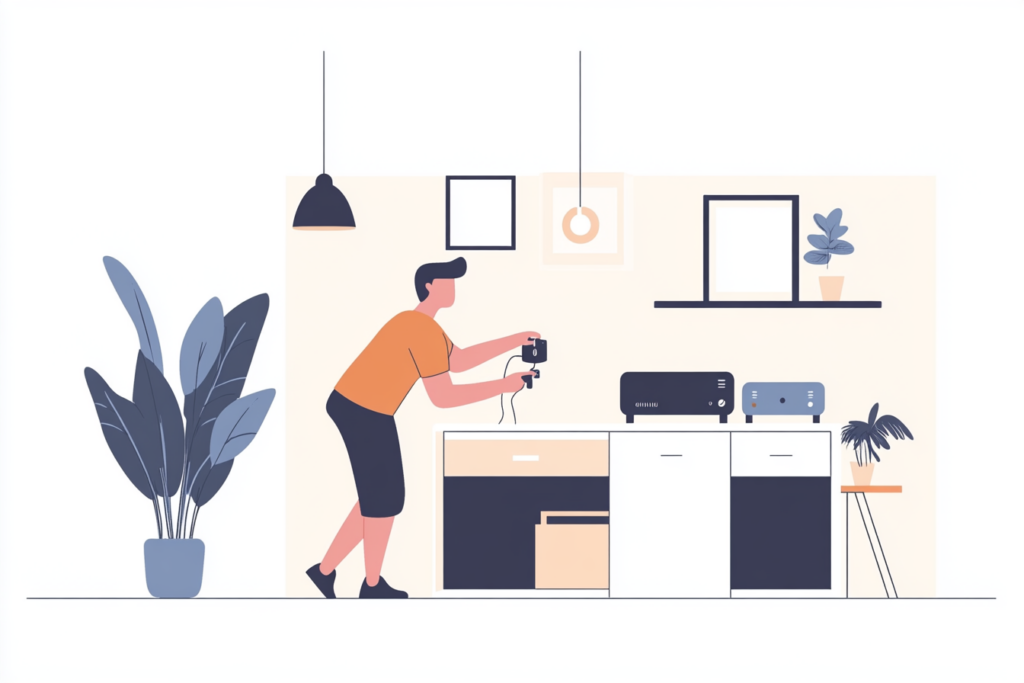Securing your home doesn’t stop at alarms and cameras. It is also about understanding the potential vulnerabilities that could make your home a target for intruders.
Conducting a thorough home security audit is vital to identifying and addressing any weaknesses. We will share steps to take and help you create a comprehensive security plan that fits your needs and gives you peace of mind whether you are home or away.
Step 1: Exterior Inspection
The first step to securing your home starts with an exterior inspection. Inspect your fences and gates around your home for any signs of wear and tear or easy entry points. Ensure all latches function properly. Consider installing automatic locks or adding padlocks for extra security.
Inspect outbuildings, sheds, and garages to ensure they are securely locked. These structures often contain tools or ladders that could be used to gain access to your home.
Stop Overspending: Common Money Traps Inside Your Home
Landscaping Considerations
Overgrown bushes and trees near windows or doors can provide cover for intruders. Regularly trim them to maintain clear visibility around entry points.
We have solar lights around the entire perimeter of our fence that light up at night. Another option to consider is motion detection lights directed toward the fence or gate.
Step 2: Entry Points Evaluation
Conduct a thorough check to ensure all exterior doors and windows are lockable and have quality deadbolt options.
You’d be surprised how many people have a window in their house that doesn’t latch quite right, and they just leave it, making it the perfect entry point for an intruder. Our house was broken into because one window by our television was left unlocked on the first floor, and an intruder climbed through easily.
The Roof Over Your Head Could Cost You More Than You Think
Add secondary locks or window pins for added security. We slide a piece of wood behind our glass door at night or when we are on vacation for an extra layer of protection. This is especially important for windows that aren’t used very often, like basement windows.
Consider upgrading to laminated or tempered glass, which is harder to break. For additional protection, window security film can be applied.
Garage and Basement Entrances
Ensure the garage door is in good working order and has a secure locking mechanism. Consider adding a garage door security bar.
Step 3: Interior Security

The Real Price of Loving Your Pet
If you are serious about keeping your home secure, you likely have installed a home security system already. But when was the last time you checked the alarm?
Testing your alarm system regularly is important to ensure it is functioning properly. If you don’t have an alarm system, consider installing one with door/window sensors, motion detectors, and a loud siren, at the very least, for when you are out of town.
Camera placement is key for security measures. We have a front door camera and one over our garage door, but we didn’t realize our garage door camera was not collecting data until we had an incident in our neighborhood, and the police department asked if they could use our footage for any information on a stolen vehicle. If we had been checking it regularly, we would have realized that the system was broken and could have adjusted our security measures sooner!
Cameras should be visible to deter intruders but also out of reach to prevent tampering (above a garage is a great place if they are in working order).
Don’t make our mistake. Make sure your cameras are recording and that the footage is being stored securely, either locally or in the cloud. Check that your cameras have sufficient storage capacity and are set to overwrite old footage automatically.
Lighting and Motion Detectors
Light timers aren’t only for the Christmas tree! You can use timers or smart lighting systems to simulate occupancy when you’re not home year-round, which is a great deterrent for intruders.
Another interior security option is to install motion detection sensors in areas where intruders will likely pass, such as hallways or stairwells. By linking these to your security system or lights, you will be immediately alerted if there is any movement. Make sure to turn this setting on only when you are gone or asleep, as you do not want to be notified every time you walk to the kitchen. Also, if you have a large dog, they can trigger the cameras, which is something to be aware of.
The Danger of Letting Balances Sit
Step 4: Digital Security
Ensure your home Wi-Fi network is protected with a strong password and WPA3 encryption. Regularly update your router’s firmware to protect against vulnerabilities. If you are really concerned about privacy, you can even set up a guest network for anyone visiting your home to keep your core network secure.
Smart Home Devices
Make sure all smart home devices, such as smart locks, cameras, and lights, are secure. Change default passwords and regularly update firmware to protect against hacking. Do not reuse passwords, as tempting as they may be.
You can always enable two-factor authentication (2FA) on your smart home devices and accounts to add an extra layer of security.
When “Do It Yourself” Becomes a Money Pit
Step 5: Emergency Preparedness
It is important to have a plan in place for you and your family in case there is an emergency at your house and to ensure that everyone living under your roof is aware of said plan.
Conduct regular security drills with your family to ensure everyone knows what to do in case of an intrusion. If you have young children, it doesn’t hurt to have a few practice scenarios to see the gaps in the communication and plan with your family.
Create and rehearse an escape plan, ensuring that all family members know the quickest and safest way to exit the house in an emergency.
Emergency Contacts
Make sure you have an updated list of emergency contacts, including local law enforcement, neighbors, and security monitoring services. Keep this list easily accessible.
Step 6: Reviewing & Updating Your Security Plan
It is important to fully conduct a home security audit at least once a year or after any major changes to your home, such as renovations or the installation of new technology.
Keep up-to-date with the latest security trends and technology. Don’t be afraid to adapt and change your plan as long as you inform everyone you live with about the updates!
Stay Safe
A home security audit is an essential process for ensuring the safety and security of your home and loved ones.
By following these six easy steps, you can confidently identify and address any vulnerabilities before they are exploited. Remember, the goal is not just to deter intruders but to make your home as secure as possible from all potential threats. Regularly updating your security measures will provide peace of mind and help keep your home safe.
You might also be interested in: How to Choose the Best Home Security System for Your Needs




